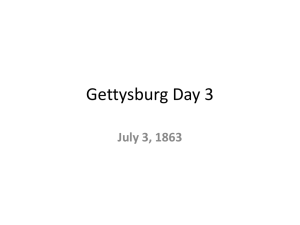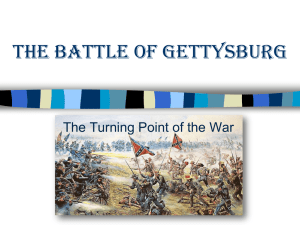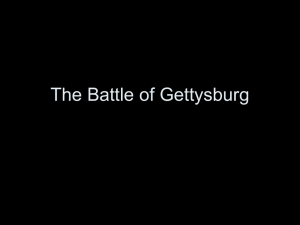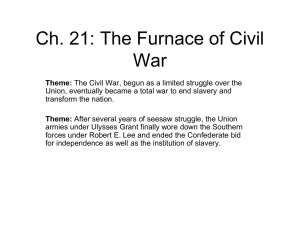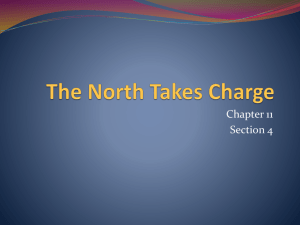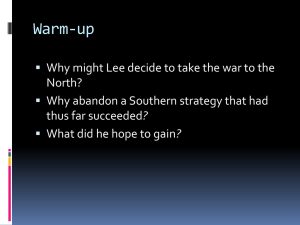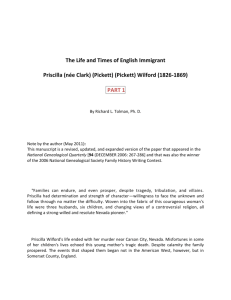Harrison Brink
advertisement
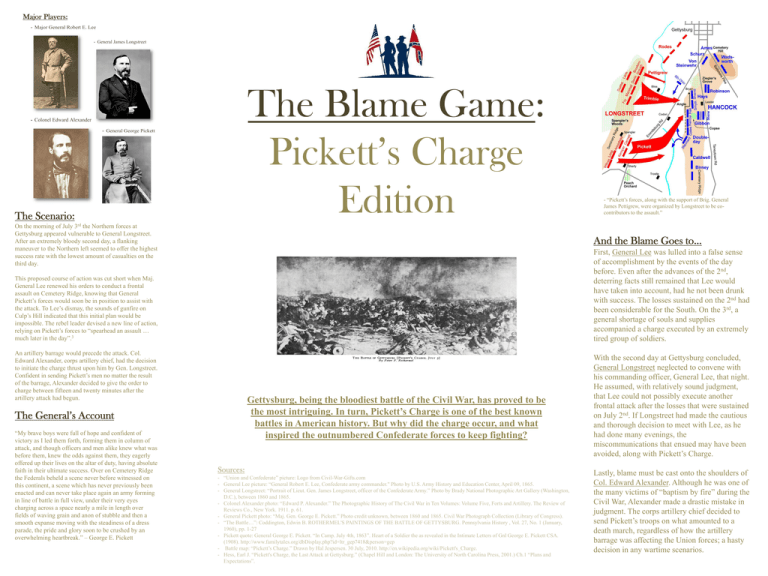
Major Players: - Major General Robert E. Lee - General James Longstreet The Blame Game: Pickett’s Charge Edition - Colonel Edward Alexander - General George Pickett The Scenario: On the morning of July 3rd the Northern forces at Gettysburg appeared vulnerable to General Longstreet. After an extremely bloody second day, a flanking maneuver to the Northern left seemed to offer the highest success rate with the lowest amount of casualties on the third day. And the Blame Goes to… First, General Lee was lulled into a false sense of accomplishment by the events of the day before. Even after the advances of the 2nd, deterring facts still remained that Lee would have taken into account, had he not been drunk with success. The losses sustained on the 2nd had been considerable for the South. On the 3rd, a general shortage of souls and supplies accompanied a charge executed by an extremely tired group of soldiers. This proposed course of action was cut short when Maj. General Lee renewed his orders to conduct a frontal assault on Cemetery Ridge, knowing that General Pickett’s forces would soon be in position to assist with the attack. To Lee’s dismay, the sounds of gunfire on Culp’s Hill indicated that this initial plan would be impossible. The rebel leader devised a new line of action, relying on Pickett’s forces to “spearhead an assault … much later in the day”.3 An artillery barrage would precede the attack. Col. Edward Alexander, corps artillery chief, had the decision to initiate the charge thrust upon him by Gen. Longstreet. Confident in sending Pickett’s men no matter the result of the barrage, Alexander decided to give the order to charge between fifteen and twenty minutes after the artillery attack had begun. Gettysburg, being the bloodiest battle of the Civil War, has proved to be the most intriguing. In turn, Pickett’s Charge is one of the best known battles in American history. But why did the charge occur, and what inspired the outnumbered Confederate forces to keep fighting? The General’s Account “My brave boys were full of hope and confident of victory as I led them forth, forming them in column of attack, and though officers and men alike knew what was before them, knew the odds against them, they eagerly offered up their lives on the altar of duty, having absolute faith in their ultimate success. Over on Cemetery Ridge the Federals beheld a scene never before witnessed on this continent, a scene which has never previously been enacted and can never take place again an army forming in line of battle in full view, under their very eyes charging across a space nearly a mile in length over fields of waving grain and anon of stubble and then a smooth expanse moving with the steadiness of a dress parade, the pride and glory soon to be crushed by an overwhelming heartbreak.” – George E. Pickett - “Pickett’s forces, along with the support of Brig. General James Pettigrew, were organized by Longstreet to be cocontributors to the assault.” Sources: - “Union and Confederate” picture: Logo from Civil-War-Gifts.com - General Lee picture: “General Robert E. Lee, Confederate army commander." Photo by U.S. Army History and Education Center, April 09, 1865. - General Longstreet: “Portrait of Lieut. Gen. James Longstreet, officer of the Confederate Army.” Photo by Brady National Photographic Art Gallery (Washington, D.C.), between 1860 and 1865. - Colonel Alexander photo: “Edward P. Alexander.” The Photographic History of The Civil War in Ten Volumes: Volume Five, Forts and Artillery. The Review of Reviews Co., New York. 1911. p. 61. - General Pickett photo: “Maj. Gen. George E. Pickett.” Photo credit unknown, between 1860 and 1865. Civil War Photograph Collection (Library of Congress). - “The Battle…”: Coddington, Edwin B. ROTHERMEL'S PAINTINGS OF THE BATTLE OF GETTYSBURG. Pennsylvania History , Vol. 27, No. 1 (January, 1960), pp. 1-27 - Pickett quote: General George E. Pickett. “In Camp. July 4th, 1863”. Heart of a Soldier the as revealed in the Intimate Letters of Gnl George E. Pickett CSA. (1908). http://www.familytales.org/dbDisplay.php?id=ltr_gep7418&person=gep - Battle map: “Pickett’s Charge.” Drawn by Hal Jespersen. 30 July, 2010. http://en.wikipedia.org/wiki/Pickett's_Charge. - Hess, Earl J. “Pickett's Charge, the Last Attack at Gettysburg.” (Chapel Hill and London: The University of North Carolina Press, 2001.) Ch.1 “Plans and Expectations”. With the second day at Gettysburg concluded, General Longstreet neglected to convene with his commanding officer, General Lee, that night. He assumed, with relatively sound judgment, that Lee could not possibly execute another frontal attack after the losses that were sustained on July 2nd. If Longstreet had made the cautious and thorough decision to meet with Lee, as he had done many evenings, the miscommunications that ensued may have been avoided, along with Pickett’s Charge. Lastly, blame must be cast onto the shoulders of Col. Edward Alexander. Although he was one of the many victims of “baptism by fire” during the Civil War, Alexander made a drastic mistake in judgment. The corps artillery chief decided to send Pickett’s troops on what amounted to a death march, regardless of how the artillery barrage was affecting the Union forces; a hasty decision in any wartime scenarios.

